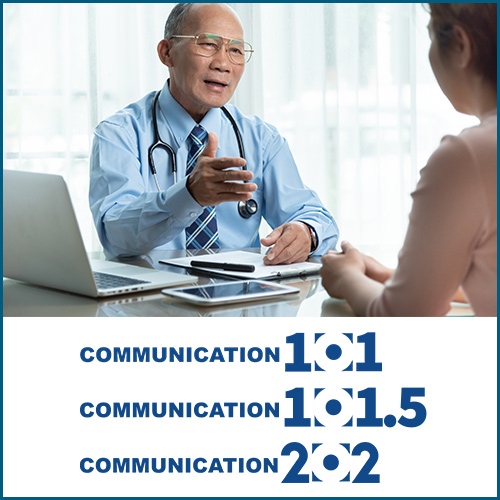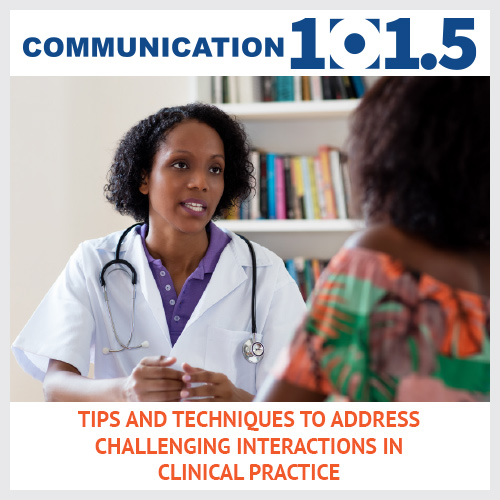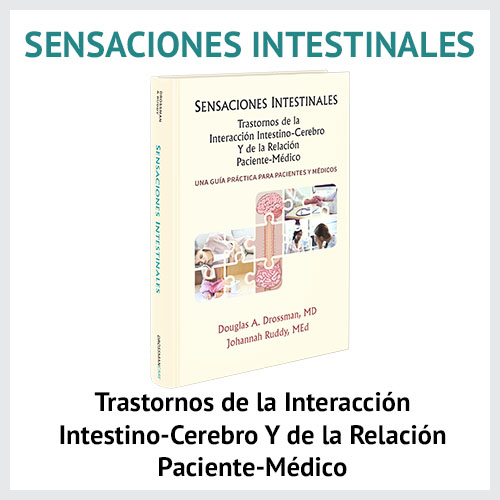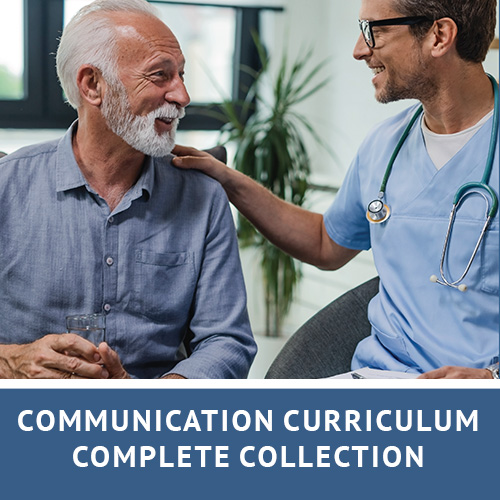Description
The communication bundle is a must have for clinicians!
This video bundle offers a progressive learning approach to advance your communication skills and improve patient and provider care satisfaction. Starting with learning the basic information to educate your patients (101), the learner moves on to handle the most common challenging situations that arise in DGBI care (101.5). Once these skills are acquired, the provider can learn more sophisticated methods to elicit underlying issues that generate the symptoms and the techniques to remedy them (202).
The Rome Foundation, in collaboration with DrossmanCare, and leveraging the Foundation’s global network of established experts in the field, develops educational programs in communication skills training aimed toward clinicians.

Learn More about Communication 101
Return to this page to purchase the bundle
A Video Approach to Help Clinicians Rapidly Convey Key Clinical Messages to Patients with Disorders of Gut-Brain Interaction (DGBI)
Anti-Diarrheal Treatments
- Dr. Cash: How to Explain Antidiarrheal Treatments
- Dr. Lucak: How to Explain Treatments for IBS with Diarrhea
Behavioral Treatments
- Dr. Keefer How to Explain Hypnotherapy and Cognitive Behavioral Therapy for IBS-M
- Dr. Keefer: How to Explain Psychotherapy Options to a Reluctant Patient
- Dr. Kinsinger: How to Explain Hypnotherapy and Cognitive Behavioral Therapy
- Dr. Tack: How to Explain Referral for Psychological Treatment
Using Central Neuromodulators
- Dr. Halpert: How to Explain the Use of Neuromodulators
- Dr. Sayuk: How to Explain the Use of Central Neuromodulators (Antidepressants) for Abdominal Pain
- Dr. Tack: How to Explain the Use of Neuromodulators to a Patient with CAPS Seeking Opioids
Explaining Constipation and Pelvic Floor Dysfunction
- Dr. Harris: How to Explain Dyssynergic Defecation (Pelvic Floor Dysfunction)
- Dr. Lucak: How to Explain Chronic Constipation
Diet
- Dr. Chey: How to Explain a Low FODMAP Diet
- Dr. Harris: How to Explain a Low FODMAP Diet
- Dr. Kinsinger: How to Re-Educate Patients Who Over-Restrict Their Diet
- Dr. Lacy: How to Explain a Low FODMAP Diet
Explaining Common Diagnoses
- Dr. Cash: How to Explain Opioid Induced Constipation
- Dr. Chey: How to Explain Functional Dyspepsia
- Dr. Sayuk: How to Address Patients Who Demand Narcotic
- Dr. Simren: How to Explain Irritable Bowel Syndrome
Explaining the Gut-Brain Axis
- Dr. Chang: How to Explain the Brain-Gut Axis, Pain Regulation and the Use of Neuromodulators
- Dr. Drossman: How to Explain the Brain-Gut Axis and the Pathophysiology of Chronic Pain
- Dr. Halpert: How to Explain the Brain-Gut Axis
- Dr. Lucak: How to Explain the Brain-Gut Axis
- Dr. Sayuk: How to Explain the Brain-Gut Axis
Explaining the Microbiome
- Dr. Chey: How to Explain the Microbiome
- Dr. Simren: How to Explain the Microbiome
Patient Communication Relating to Abuse/Trauma
- Dr. Chang: How to Facilitate Discussion of Sensitive Topics (e.g., Abuse)
Pediatric Issues
- Dr. Nurko: How to Explain a Child’s Abdominal Pain and Constipation to the Parent
- Dr. Nurko: How to Explain to an Adolescent and Her Mother About Abdominal Pain and the Use of Neuromodulators
Explaining Peripheral Neuromodulators (Secretagogues and Prokinetics)
- Dr. Cash: How to Explain the Use of Peripheral Neuromodulators (Secretagogues and Prokinetic Agents) for Constipation
- Dr. Lacy: How to Explain the use of Secretagogues (Peripheral Neuromodulator) for Constipation
- Dr. Lembo: How to Explain the Use of Prokinetics (Peripheral Neuromodulators) for Constipation

Learn More about Communication 101.5
Return to this page to purchase the bundle
Resolving Challenging Interactions in Clinical Practice: Tips and Techniques
- Patient Requesting Opioids: Patient wanting Opioids
- Patient Requesting Antibiotics for “SIBO”: Patient wants to go on another course of antibiotics, convinced she has SIBO when recent breath tests were negative and one in the past was positive
- Patient Wanting Tests to Exclude Cancer: Patient convinced she has cancer. She is not accepting a DGBI and wants more testing to be sure it hasn’t been missed
- Patient Seeing Doctors for Non-credible Diagnoses: Patient presents with abdominal pain and diarrhea. She went to patient websites and google and is convinced she has diagnoses of lyme disease, mast-cell activation disease, median acrcuate ligament syndrome (MALS), gastroparesis (slight abnormal GE) and porphyria and wants treatment
- Teenager with Overinvolved Mother: Addressing helicopter parent taking responsibility for adolescent child
- Patient Refusing Neuromodulators: Patient reluctant to take a neuromodulator because it means she’s crazy
- Achieving Collaborative Care: Patient “trashing” other doctors for not making a diagnosis and not treating her very well. Raises expectations that “you will help me where others have failed”
- Patient Reluctant to Discuss History of Trauma: Patient mentions history of trauma, but uncomfortable about disclosing further

Learn More about Communication 202
Return to this page to purchase the bundle
Communication 202: A Deeper Understanding of GI Illness Through a Patient Centered Approach
- Case Vignette 1: A 17-year-old adolescent attending an exclusive girl’s school is referred after an episode of hematemesis. She was diagnosed by endoscopy to have a (Mallory-Weiss) tear.
- Case Vignette 2: A 37-year-old hospital pharmacist with a long-standing history of abdominal pain and diarrhea has had multiple hospitalizations with IV narcotic treatment. Multiple diagnostic studies have been negative. She is requesting hospitalization for diagnosis, treatment and cure.
- Case Vignette 3: A 42-year-old man has a diagnosis of Crohn’s Ileocolitis which is being treated with mesalamine. His concern is that of rectal pain and diarrhea that has worsened over the past several weeks.
- Case Vignette 4: A 23-year-old woman presents with abdominal pain, infrequent hard stools and straining and blood on the toilet tissue with defecation. She requests that the doctor not do a rectal exam.
- Case Vignette 5: A 33-year-old lawyer reports abdominal pain, fatigue, and nausea for two years. She describes the pain as “aching…like an emptiness.” The symptoms are worse at bedtime and prevent sleeping. The evaluation has been negative. The symptoms interfere with work and social activities.
- Case Vignette 6: A 64-year-old executive prides himself on his good health and successful career. He presents with a 6-month history of epigastric burning made worse with eating that is only partially relieved by acid blocking medication. The visit was initiated for continued difficulties in carrying out work, and on several occasions, he had to leave business meetings because of the pain.
Bundle Package Price – $299.00
Off the combined list price of $389.85






